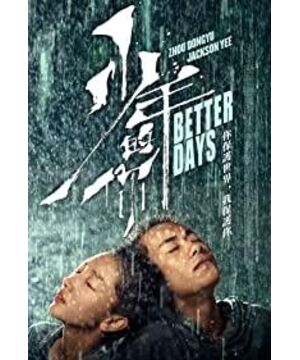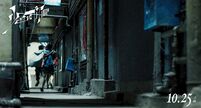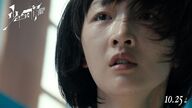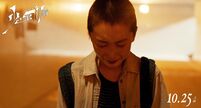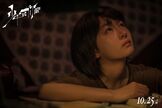(Originally posted on Phoenix.com, this draft is the first draft without revision)
Face = phone
There is a puzzling thing in the movie "You are a teenager": two teenagers who have been bullied have new scars on their faces, but after a few days, the wounds will quietly shed and their faces have changed. This is not so much a modeling error as it is a subconscious aesthetic practice. It has a deep connection with the film.
Back to Xiaobei and Chen Nian met for the first time: Xiaobei was beaten, Chen Nian was upset, called the police, and was knocked to the ground. The gang pulled up Xiaobei's bloodstained face and faced Chen Nian. Chen Nian was pushed and the phone slid across the ground. In the next scene, a close-up reveals that the phone screen has been shattered and noise is flickering. Here, the movie makes a beautiful comparison, that is, mobile phone = human face.
The mobile phone, this ghost that shouldn't exist in the senior year of high school, showed a certain sense of autonomy under the care of many close-ups. Xiaobei repaired his cellphone in the same way as he repaired scars. The face is the display interface of the human body, which shows damage and does not damage the body (body). The face can be updated and replaced at any time. The scar becomes a decoration, fashionable tattoos are no longer permanent. It is erased with the cell renewal of the teenager. And this state of "barbaric growth" can also be described as China's overcapacity electronics manufacturing industry. China is the largest country in the production of mobile phones, and Chongqing, where the film was shot, is the second largest producer of mobile phones in China. After the export of mobile phones, a large amount of electronic waste has been turned around and finally returned to this land. "Young You" approaches Cyber Punk's science fiction film in the digital processing of the human body. Xiaobei and Chen Nian are also two embryonic Cyborgs.
In the real world, the face and mobile phone's "seeing each other" is gradually strengthening. Face Time, Facebook uses the "face" in the name to emphasize their humanity, Tinder, Tantan, one person, one face, facial recognition is gradually occupying the mainstream of identity verification technology, and mobile phone users are trapped in the world of mirroring and portraits. . When mobile photography has become a trend in contemporary digital cinema, the focus on faces has reached the point where it cannot be added. For example, "Orange" and "Heartless" shot by mobile phones are full of close-ups of faces. The camera is a deformed monster and always likes to become something close to its size. Although "Young You" was not filmed with a mobile phone, it still consciously adopted contemporary vision, with fast editing, close-ups, and shallow depth of field. The mobile phone display has no thickness, and some passages in the movie also use a very shallow depth of field (such as a prisoner car fantasy passage), making the face almost a flat surface. The two planes can move closer or farther away, but never merge, highlighting the fantasy nature of this passage and further clarifying the loneliness of people in the "screen age".
Cultural Drift and Killing Matt
Another striking feature of the film is its color aesthetics. Pure red, green and blue appear many times in the film. In classic color movies, color is often related to emotional rendering, but "Youth in Youth" doesn't seem to mean it. In the RGB color space, red, green and blue are located at the edge of the space and are the ultimate colors. There is a classic data compression experiment, a picture is repeatedly recompressed in JPEG format, and the final picture will appear as a green. In the random information drifting, the delicate balance is broken, and finally slid to the limit. In some of Godard's recent works, such as "Goodbye Language" and "The Book of Images", he recklessly played with this color distortion to emphasize the indirectness of images.
This color phenomenon is similar to the formation of the Shamat culture. As we all know, Shamat culture prefers bright red, bright yellow, bright green and other colors, which is far from its ancestor, Japanese visual rock. It is precisely because of the blockage of communications that kill Matt fans imitate some inferior printed or audio-visual products, and the information is lost step by step, and finally such a "cultural drift" is formed. Xiaobei can be called half-killing Matt. Chen Nian and him are living in the cecum of culture and economy. The waste of information metabolism pushes them to the extreme of red and green. Even when they put on white cloth and pretend to be ghosts, they were also dyed red by shoddy street lights. In sharp contrast, when the camera entered Wei Lai's home, we saw a peaceful white. Red and green are the colors of the lower layer, while white is owned by the upper layer. This feature is also continuously confirmed by the system. A quick montage shows that the mock test scores of all students are neatly arranged, and are marked in red or green, different from their performance. This shocking separation gave people a layer of understanding of the extreme emotions that erupted from Chen Nian and Xiaobei. When the film progressed to the interrogation stage, different people were seated, and the room was all pale, and it seemed more holy and peaceful than the horrible depression. Finally, Chen Nian and Xiaobei can have a complete spectrum. At this time, Chen Nian's phrase "The college entrance examination is the only equal opportunity" is not considered delirium. Perhaps we can also say "In the interrogation room, we are all equal." When Chen Nian grew up, the environment was also balanced. White. On the bright trail, Xiaobei escorted Chen Nian. It is worth noting that when we observe Xiaobei through surveillance, we can see that the red and green pixels overflow its body, and the evil ghosts of the lower layers follow like a shadow.
At the same time, the text of the film also presents a peculiar cultural fusion. The squatters built by Xiaobei under the viaduct (which would obviously be quickly demolished in the context of the mainland), the rain for days and the fights in the back alleys all evoke the memories of Hong Kong movies. Perhaps in Chongqing, the "most Hong Kong city", Zeng Guoxiang quoted "Young and Dangerous." And Hong Kong, like Beijing repeatedly mentioned, is a desperate export and a complete cultural spectrum. In addition, some viewers mentioned that Jiuzuki's original text was influenced by Keigo Higashino, and Zeng Guoxiang himself is also a fan of Shunji Iwai. The shadow of "Everything About Lily Zhou" is vaguely visible in the film. Multiple forces converge in a familiar and unfamiliar plot, and we live in the cultural "gutter" like the characters, and then continue to decline. But is it not a cultural reality that we must face?
Digital communication mode and its antidote
After the incident of Hu Xiaodie's jumping from a building, the film used a few quick close-ups to explain the reactions of the students in the WeChat group: brief and indifferent questions, a series of exclamation points, and an emoji that expressed "scared silly". Emoticons, characters and Chen Nian's face are cross-edited to form a set of contemporary "Odessa Ladder" montages. The film uses a very bold way to push the "flatness" of contemporary movies to the end.
In "Everything About Lily Chow", one of the earliest films depicting the digital age, the characters are continuously and anonymously created in the impulse of youth. Characters replaced human faces, expressions, and voices, and it became the movie itself. In the Internet age, the space for communication has been cancelled, and dialogue has become a continuous string of strings. Emotions are reduced to expressions, and expressions are often attached to a simple textual meaning. The text cannot be merged, the expressions cannot be overlapped, and the dialogue becomes a real "speak to each other", sending-reply-sending-reply, forming a mechanical cycle, unable to resonate.
In "Young You", not only the "silent majority", even Chen Nian and Xiao Bei also stepped into the river of strings unconsciously. The communication between the two is not everyday, and the rhythm is close to the back and forth of the pendulum of your question and me answer. Most of them reveal their own thoughts, but rarely engage in close confrontation on a topic. The only passage that may be close to the "dialogue"-discussing how to commit the crime, happened to be omitted by the narrative. With the combined efforts of digital communication and censorship, some of the usual emotional exchanges have also taken on the characteristics of "WeChat chat". Such as Xiaobei injured and sleeping in bed with Chen Nian. The two had no physical contact. Xiaobei began to tell about his childhood experience, tears falling from the outer corner of his eyes, and then cut to Chen Nian, the tears also falling from the outer corner of his eyes. Xiaobei turned over, another tear slipped from the corner of his eyes, and Chen Nian did the same. The movement of these two groups of tears in the same direction reminds one of the "fighting pictures" in online communication. In traditional movies, the relationship between couples is often established through eye contact or physical contact. When chatting online, there is no sight or physical contact. The expressions of the two parties, as ghosts of their respective owners, meet and converge in an imaginary space, both point-to-point and displayed in the chat window. This is exactly the logic of the first half of "You Are", and it is also the logic of many contemporary movies.
How is "emotion" born in a string, and can "love" be encoded? Contemporary love survives between the mechanization of people and the digitalization of communication, and it is difficult to see the future. Faced with this situation, the film gave a powerful antidote towards the end. That was the meeting between Chen Nian and Xiao Bei in the detention center, and the two looked at each other through the glass. The faces of the two were superimposed on each other, absorbed, contained. Emotion flows and is continuous. That is the overlap of one string of characters and another, a program error, an impossible encounter in the digital world. Through this tiny miracle, we finally have reason to believe in the power of movies and love in a broken age.
View more about Better Days reviews


